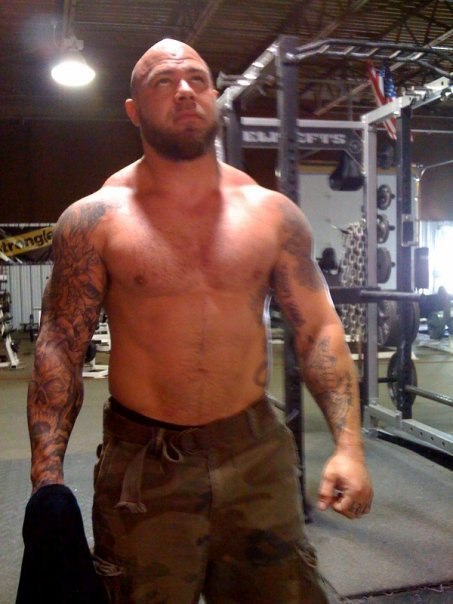The Mountains Supporting Your Head
The rule to getting a massive yoke is simple: get really strong.
Not "strong for my public gym," but "strong in the eyes of the strong." Weak people can have big arms but you can't fake a big yoke.
Achieve the impossible in strength and the yoke will come. Cop out with your excuses of why you literally can't and be doomed with pebbles where mountains should reside.
The best specialization training is not throwing out the core of your program to accommodate the body part being targeted, but integrating it into a balanced strength program, which means your squat, clean, press, deadlift, and bench press won't be compromised.
And really, a proper strength program will already have, at its roots, the fundamental movements to achieving proper Yokedom.
The Main Lifts
- Squat
- Bench Press
- Press
- Deadlift
- Power Clean
The hang clean, power snatch, or hang snatch can be done in place of the power clean. If you do the hang versions of these lifts, use straps for the heavier sets. These lifts are nothing new or terribly fascinating, but this is the foundation of the program.
- The 4-day breakdown
- Monday: Press
- Tuesday: Hang clean/Deadlift
- Thursday: Bench press
- Friday: Power clean/squat
You can do the power clean or any other similar movement before the squat or the deadlift; or before the squat AND the deadlift. It's up to you and really doesn't make a difference. Strong people make things work.
The sets and reps on these five main lifts are also up to you, meaning that if you have a proven training system that allows you to progress towards your goals, use it. Of course, I'm partial to the 5/3/1 training program for these lifts.
Don't be afraid to do 5+ reps on the power clean if you're strong enough to hold your form. You're right, Olympic lifters don't do high reps, but I highly doubt you're an Olympic lifter and doing some higher reps on these exercises can help you build a bigger yoke.
Don't do the reps if you can't perform the lift correctly in a fatigued state. I can't believe I had to write that, but judging by the recent trend of using barbell lifts, namely the Olympic lifts, for conditioning circuits by untrained and unqualified lifters, it's now a necessity.
If you're strong and awesome, you can do them. If you're presently a novice and/or weak, lay off the higher reps.

Assistance Work
Monday
Press: 5/3/1 sets and reps
Press - 50 total reps @ FSL
Assistance:
Push - 25-50 total reps
Pull - 25-50 total reps
Single leg/Core -25-50 total reps
Tuesday
Hang Clean - 15-25 total reps @ SSL
Deadlift: 5/3/1 sets and reps
Deadlift - 25 reps @ FSL
Assistance:
Push - 25-50 total reps
Pull - 25-50 total reps
Single leg/Core -25-50 total reps
Thursday
Bench press: 5/3/1 sets and reps
Bench press - 50 total reps @ FSL
Assistance:
Push - 25-50 total reps
Pull - 25-50 total reps
Single leg/Core -25-50 total reps
Friday
Power clean - 15-25 reps @ SSL
Squat - 5/3/1 sets and reps
Squat - 25 total reps @ FSL
Assistance:
Push - 25-50 total reps
Pull - 25-50 total reps
Single leg/Core -25-50 total reps
Major Assistance Yoke Work
Here are some more awesome assistance exercises for developing a superior yoke:
- Kroc rows: These have been written about extensively.
- Kirk Karwoski rows: This is like a shrug/upright row hybrid. Holding a heavy barbell, shrug and row it up to your belly button. Hold for a second at the top and repeat. With heavy weight and high reps, this is also great for grip strength.
- Shrugs (of all kinds): Just don't use more english than trap when doing these.
- Any row or pulldown exercise: Pull these with your elbows high and out. This will stress your upper back and traps. Make sure you're actively squeezing your upper back together at the end of each rep.
- Semi-upright T-bar rows: This is my new favorite trap exercise. I do sets of 20 reps in between all my press sets. This is something like a Kirk Karwoski row.
- Glenn Buechlein kettlebell shrugs: Grab the heaviest kettlebells or dumbbells you can handle and do 100 reps without putting the weight down. You can hold them for as long as you want between reps but never let them rest. Start with a light weight at first and be prepared to be humbled. This is great for grip and trap work.
- Farmer's carry: While not technically an assistance exercise (in the classic sense), the farmer's walk or farmer's carry is an awesome exercise for overall body strength: grip, legs, abs, back, and of course, traps.
If you want to perform the Farmer Walk exercise heavy, don't turn it into a conditioning movement. This is beyond idiotic.
If you don't have dedicated handles for this exercise, a trap bar works well, and if you don't have a trap bar, dumbbells can work. The advantage of having dedicated handles is that you can load up a ton more weight, and if you want to be strong, at some point you're going to have to add weight to the bar.
I highly recommend a steady diet of either kettlebell swings or using the Hungarian Core Blaster (a T-bar apparatus that's plate loaded and similar in function to a kettle bell) for Single Leg/Core.
With the kettlebell work, you can do single-arm or double-arm swings. Whatever you choose, I usually shoot for 100 total reps of swings on lower body days.
The swing is great for strengthening the entire backside of your body. There's no need to go too heavy on these as you've already performed 2 or 3 fairly hard lifts in the workout. Shoot for a higher volume on the swings.

Minor Assistance Yoke Work
Most of these are done for higher reps (10-30) and are an awesome way to increase your yoke volume and thickness.
- Rear dumbbell laterals: Great for balancing out the shoulder girdle.
- Side dumbbell laterals: I do these "wrong." I start with my shoulders shrugged and then do the lateral. This isn't good for shoulder development, but awesome for the traps.
- Upright row: If you're healthy, these are a great option. Try doing them with a rope attached to a low pulley.
- Seated dumbbell external rotations: These are often called seated dumbbell cleans.
- Face pulls: Great for balance and easy way to pump up your traps. If you don't have access to a pulley, use a band.
- Band pull-aparts: A staple for many, the band pull-apart is great to do between sets of pressing. Make sure you pull the band apart with straight arms and pull your scapula together.
- Standing football bar (or Swiss bar) front raise: Make sure you raise the bar in a full range of motion and end with the bar overhead. Pull your scap together at the top of the movement. This is a very humbling movement. The first set will feel easy but the subsequent sets, at the same weight, will be exhausting.
- Strict (no bend) clean and press: This one is very strange but very effective. Start with an empty barbell and do a very strict clean and press. No leg drive, no hip drive. Use nothing but your arms and shoulders to move the bar.
- Shoulder complex: Perform a barbell press for 10 reps, then do a side raise for 10 reps, and finally a rear raise for 10 reps. These three exercises, done back to back to back, constitute one set. Do three sets. This will smoke your shoulders and traps.
Getting Rid of the Stack o' Dimes
Unless you have access to a 4-way neck machine, we're going to forego training "the sides" of the neck. Using the neck harness and neck flexion work will provide plenty of "side neck" stimulus.
If you do have access to a 4 way neck machine, you're a lucky person. Use it and abuse it after every workout: 100 reps/each way.
Ease into training the neck. You don't want to jump into neck training with high volume and heavy weights. So if this is your first invite to the neck party, take it slow. Only do half of the reps and sets (when applicable) and work up to the recommendations over the course of a month.
Don't get so excited that you go too heavy or use a limited range of motion; strapping weight to your head demands that you use a full range of motion and aren't interested in the weight being moved. Instead, be interested in getting the full benefits of proper training and form.
No one cares what you use for neck work, just like no one cares what you curl or do on any assistance exercise. There are no gold medals handed out for the neck harness king.
There are many types of neck harnesses available. I've had a leather neck harness for almost a decade now and it still holds up fine. I've also had a cheap, nylon neck harness that worked very well. The leather harness is infinitely more comfortable.

To use a neck harness, attach a dumbbell or plate to the chain and "yes/no" your head.
You can do these seated on a bench, leaning forward, hands or elbows on your thighs, and weight dangling between your legs. You can also do them standing up, with a slight lean forward, your hands resting on a stationary object.
Whichever you choose, make sure you use a full range of motion, chin touching your chest on each rep and then extend until your face is facing forward. You don't need to toughen up the exercise by hanging chains on the harness.
Neck Flexion
To do this, lay on a flat bench and hang your head off the end. Place a towel on your forehead and place a weight plate on it. Bring your head back as far as you can and then bring your chin to your chest.
Several neck training options:
- 50-100 reps of flexion and/or extension each workout. This is done over as many sets as you want.
- 2 sets of 25-50 reps of flexion and/or extension when you wake up and when you go to bed. This is done every day.
- 1 set of 50+ reps of flexion and/or extension each workout. This is obviously done with a very light weight.
- Perform 1 set (a warm-up) for a set of 15-20 reps. Then choose a goal weight and do as many reps as you can. For my all-out set, I try to shoot for 15+ reps. For example, using the neck harness, do:
1 set of 20 reps with 25 pounds (warm-up)
1 set of 18 reps with 70 pounds
Caution: Don't try to max out or use a weight you're not prepared for. I've done something this stupid and have paid greatly.
I usually change the neck work for each workout as the key to training the neck is range of motion and consistency. For the neck flexion work, I use a 25, 35 and 45-pound plate. I don't go overboard.
Everyday Yoke Work
Along with the main workouts, feel free to do some lighter yoke work on your off days. I recommend this simple program:
- Neck harness or neck flexion: 100 reps (done in as few sets as possible)
- Face pulls or band pull-aparts: 100 reps (choose one of the exercises and do 100 reps in as few sets as possible).
This can be done every day or just on your off days. I highly recommend doing this a set at a time every day, either when you wake up or right before you go to bed. Establish a habit.




